For near-field listening (say ears 24" or 60cm from the driver or so) I'm beginning to wonder if baffle edge/corner diffraction is more important than for longer listening distances; or at least quite important. Partly because there aren't other room reflections (of such great significance) to mask it in our perception, partly because a small distance between driver and baffle edge will be larger in an angular and directional sense, when sitting so close.
If so, this might make quite a difference on how I'd want to design a baffle - more rounded (or chamfered) at the corners, and therefore probably wider to accommodate the radius. IIRC Linkwitz said that a radius needs to be greater than 1/8th the wavelength to have much benefit. Which begs the further question how low in frequency is important for reducing edge diffraction; tweeters would be easy but full-range (or mid-range) drivers would indicate quite a significant radius or chamfer.
Three possible criteria I can think of are: low enough to reach the baffle step, below our most critical hearing range (e.g below 1khz, possibly lower), or to cover the range of the driver in the baffle. In the former case that could become slightly iterative, since a bigger radius means a wider minimum baffle width, and therefore a lower baffle step frequency. In the latter things could get quite big - if we take an example of a 500hz (e.g. WAW/FAST type) crossover, then better than 1/8th of the wavelength would indicate about a 9cm or 3.5" radius.
Thats if it is even worth bothering, of course. TBH I don't really know where I'm going with this now. But some thoughts (or perspective) from people who understand things rather better than me would be very helpful, if anyone could offer some?
Thanks,
Kev
If so, this might make quite a difference on how I'd want to design a baffle - more rounded (or chamfered) at the corners, and therefore probably wider to accommodate the radius. IIRC Linkwitz said that a radius needs to be greater than 1/8th the wavelength to have much benefit. Which begs the further question how low in frequency is important for reducing edge diffraction; tweeters would be easy but full-range (or mid-range) drivers would indicate quite a significant radius or chamfer.
Three possible criteria I can think of are: low enough to reach the baffle step, below our most critical hearing range (e.g below 1khz, possibly lower), or to cover the range of the driver in the baffle. In the former case that could become slightly iterative, since a bigger radius means a wider minimum baffle width, and therefore a lower baffle step frequency. In the latter things could get quite big - if we take an example of a 500hz (e.g. WAW/FAST type) crossover, then better than 1/8th of the wavelength would indicate about a 9cm or 3.5" radius.
Thats if it is even worth bothering, of course. TBH I don't really know where I'm going with this now. But some thoughts (or perspective) from people who understand things rather better than me would be very helpful, if anyone could offer some?
Thanks,
Kev
I'm re-using a post I've written a while ago. The shape of the cabinet determines a lot of what the off-axis energy looks like.
A while ago member @fluid ran sims for a driver in a flat baffle and the same driver with a rounded enclosure, the last example in
this row (with the set back or we could call it a short waveguide) is what I used, based on a hunch, but apparently a good one...
The relatively flat baffle with flush mounted driver simulation in ABEC:
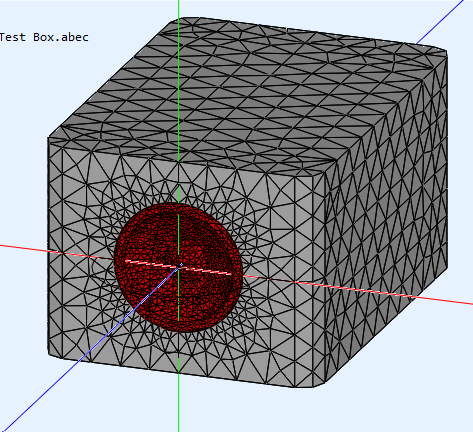
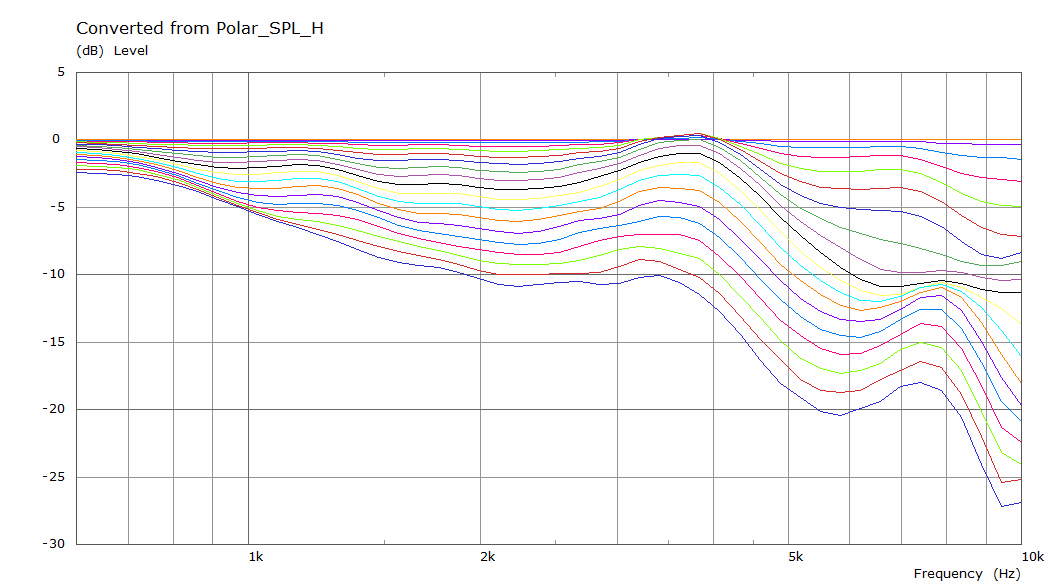
Versus the rounded enclosure with flush mounted driver:
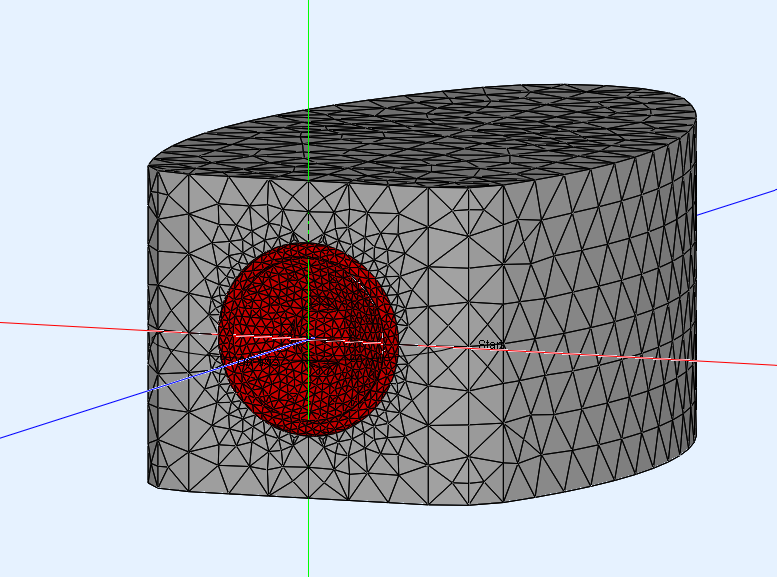
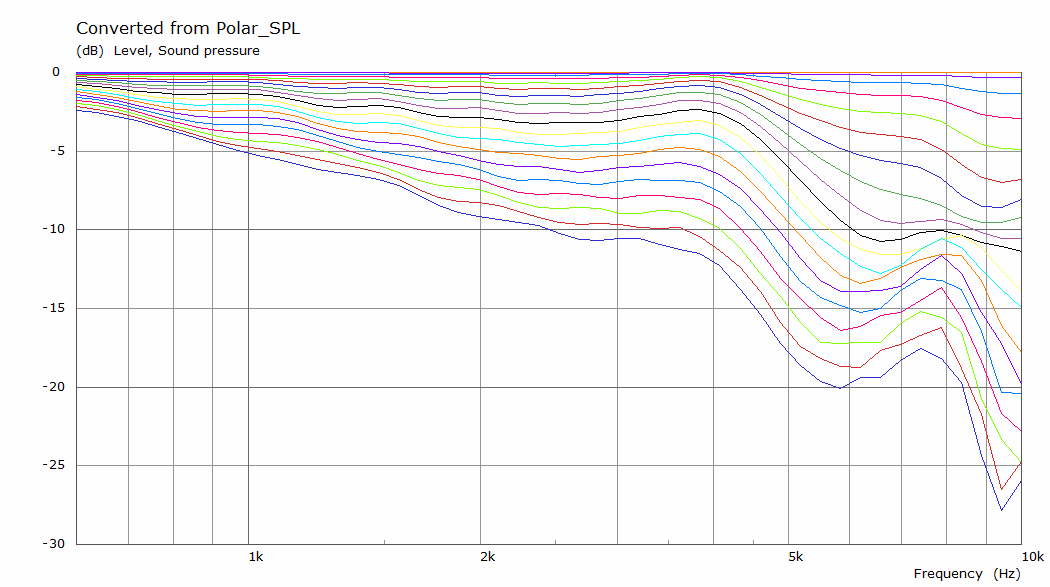
I'd say it is easy to spot differences. The first round-over used on that enclosure shape is only 25.5mm or about 1" radius. Yet the effect it has is quite obvious. A 2" round-over would get you enough of a noticeable effect i.m.h.o.
Taking this concept a step further, with the driver set back in the baffle with a small chamfer in front of the driver:
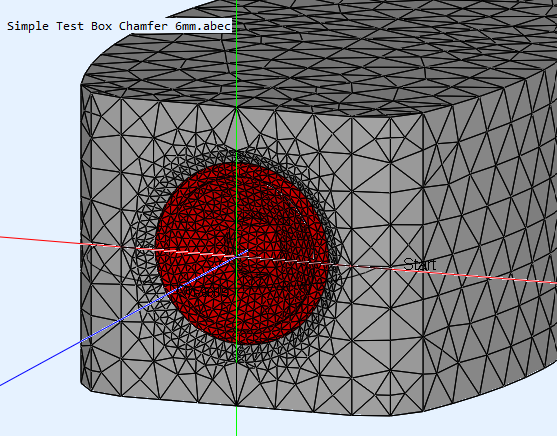
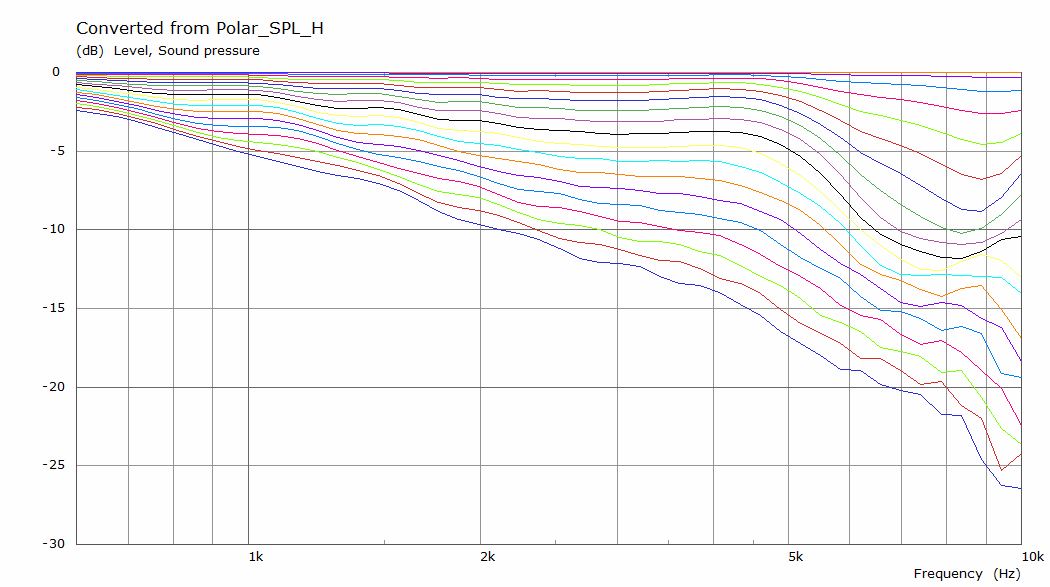
I'd say it's well worth it to try or play with things like that. It does show much the shape of the enclosure can determine the outcome.
I had chosen my enclosure shape on a hunch, but did play extensively with ripple tank software to verify it I had at least a good hunch.
The ABEC sims that were done years later seem to confirm it.
A while ago member @fluid ran sims for a driver in a flat baffle and the same driver with a rounded enclosure, the last example in
this row (with the set back or we could call it a short waveguide) is what I used, based on a hunch, but apparently a good one...
The relatively flat baffle with flush mounted driver simulation in ABEC:
Versus the rounded enclosure with flush mounted driver:
I'd say it is easy to spot differences. The first round-over used on that enclosure shape is only 25.5mm or about 1" radius. Yet the effect it has is quite obvious. A 2" round-over would get you enough of a noticeable effect i.m.h.o.
Taking this concept a step further, with the driver set back in the baffle with a small chamfer in front of the driver:
I'd say it's well worth it to try or play with things like that. It does show much the shape of the enclosure can determine the outcome.
I had chosen my enclosure shape on a hunch, but did play extensively with ripple tank software to verify it I had at least a good hunch.
The ABEC sims that were done years later seem to confirm it.
Thank you, that is most interesting, and also quite encouraging.
The set-back driver reminds me of something (perhaps by earl geddes?) which suggested that a driver in the middle of a donut-shaped baffle might have almost no edge diffraction. With 1/8th wavelength radius for a wide-range driver that would be pretty big, yet looking at your charts, perhaps only the higher frequencies need their off-axis/directivity improving; below around 2khz things are fairly decent already.
The set-back driver reminds me of something (perhaps by earl geddes?) which suggested that a driver in the middle of a donut-shaped baffle might have almost no edge diffraction. With 1/8th wavelength radius for a wide-range driver that would be pretty big, yet looking at your charts, perhaps only the higher frequencies need their off-axis/directivity improving; below around 2khz things are fairly decent already.
Last edited:
Hi kev06, simple way to think about is to think a ball has least edge diffration related seconday sound source, because there is no edge. Soubd would always diffract aroubd objects, but its the secondary sound source that forms at the edge which is the problem if any, this radiates sound toward listening window, basically the baffle edge becomes a soubd source for some bandwidth.
Since you have a driver with physical size and shape which you cannot affect then best you can do is start rounding immediately next to the driver to approximate a sphere/ball.
Just make as big roundover that fits. If only 1mm radius rounding fits, it is as good as it gets 😉 basically just minimize flat baffle area around driver and concentrate on other issues your system/box has. You could make highly asymmetrical as well, narrow and tall. Or wide, but the wider your baffle the bigger roundovers you need and back to square one, minimizing flat baffle around driver.
Also back edge diffracts, sound goes all the way around, which both find their way to listening window, but these effects are much much smaller in magnitude, so dealing with front edge is the most important if any.
You are on a right track though, thinking about the acoustic structure. Imagine you had best driver known to man kind, one-off million dollar ideal flat disk pistonic all the way from 20Hz to 20kHz, or any charasteristics you can think of. Now, think about how the structure changes the response, how it works with your room and preferences. Then you notice response is like +-3db, resonaces in the box and with the box and so on, diffration as well, basically all kinds of secondary sounds interfering with the direct sound.
Any driver is just part of a system, the structure is very big part of how it turns out in combination with how the system interacts with the room. And soon you are posting in the multiway forum 😉
Well, not sure about audibility of diffraction, but did not like my 5" fullrange system nearfield as the response varies wildly with small head movement, very hard to know if head is at sweetspot or not. Perhaps it was partly diffration, perhaps something else, perhaps yours works better.
Have fun learning and thinking and imagining! 🙂
Since you have a driver with physical size and shape which you cannot affect then best you can do is start rounding immediately next to the driver to approximate a sphere/ball.
Just make as big roundover that fits. If only 1mm radius rounding fits, it is as good as it gets 😉 basically just minimize flat baffle area around driver and concentrate on other issues your system/box has. You could make highly asymmetrical as well, narrow and tall. Or wide, but the wider your baffle the bigger roundovers you need and back to square one, minimizing flat baffle around driver.
Also back edge diffracts, sound goes all the way around, which both find their way to listening window, but these effects are much much smaller in magnitude, so dealing with front edge is the most important if any.
You are on a right track though, thinking about the acoustic structure. Imagine you had best driver known to man kind, one-off million dollar ideal flat disk pistonic all the way from 20Hz to 20kHz, or any charasteristics you can think of. Now, think about how the structure changes the response, how it works with your room and preferences. Then you notice response is like +-3db, resonaces in the box and with the box and so on, diffration as well, basically all kinds of secondary sounds interfering with the direct sound.
Any driver is just part of a system, the structure is very big part of how it turns out in combination with how the system interacts with the room. And soon you are posting in the multiway forum 😉
Well, not sure about audibility of diffraction, but did not like my 5" fullrange system nearfield as the response varies wildly with small head movement, very hard to know if head is at sweetspot or not. Perhaps it was partly diffration, perhaps something else, perhaps yours works better.
Have fun learning and thinking and imagining! 🙂
Edge diffraction is yes more a issue for midrange
and treble.
The direction you are going is good my opinion.
with wider baffles, baffle step is lower
flatter response and simplifies crossover.
Most being obsessed with very skinny baffles.
Just leads to the usual overthinking of some
superior curvy baffle shape or magic round overs
for edge diffraction.
Being that it puts a edge closer to the speaker
is not a big mystery why small baffle has edge
diffraction issue.
Once the baffle is wider, edge is less concern.
Response is flat and life goes on.
and treble.
The direction you are going is good my opinion.
with wider baffles, baffle step is lower
flatter response and simplifies crossover.
Most being obsessed with very skinny baffles.
Just leads to the usual overthinking of some
superior curvy baffle shape or magic round overs
for edge diffraction.
Being that it puts a edge closer to the speaker
is not a big mystery why small baffle has edge
diffraction issue.
Once the baffle is wider, edge is less concern.
Response is flat and life goes on.
That was my design goal with my shallow horns which measure 40cm x 40cm. I wanted the step response to be clean for at least one millisecond after the initial impulse.



^^^
Quite the opposite of what OP intended
Probably this fits
https://www.google.com/search?q=sca...rome-mobile&ie=UTF-8&chrome_dse_attribution=1
Quite the opposite of what OP intended
Probably this fits
https://www.google.com/search?q=sca...rome-mobile&ie=UTF-8&chrome_dse_attribution=1
Thank you, everyone. This is certainly confirming some suspicions that I had, and adding to my understanding. The answers aren't always convenient, of course, but they're certainly helping me to weigh the options and trade-offs more suitably.
Indeed, narrow and compact would be nice as the speakers will be so close as to be almost in one's face. But I don't want to do that at the expense of audible edge-diffraction artifacts, so it probably isn't going to happen. Some middle ground maybe, with a small recess such as in wesayso's example and only 2" or so radius round-overs.
I could also elect to use quite a small driver as the wide-range, given the close listening distance, which would help keep front baffle width reasonable and likely improve the upper frequency ranges too. That might indicate a WAW/FAST configuration, but the woofers could be on the sides instead of the front baffle.
Indeed, narrow and compact would be nice as the speakers will be so close as to be almost in one's face. But I don't want to do that at the expense of audible edge-diffraction artifacts, so it probably isn't going to happen. Some middle ground maybe, with a small recess such as in wesayso's example and only 2" or so radius round-overs.
I could also elect to use quite a small driver as the wide-range, given the close listening distance, which would help keep front baffle width reasonable and likely improve the upper frequency ranges too. That might indicate a WAW/FAST configuration, but the woofers could be on the sides instead of the front baffle.
It is better not to overthink.
You just simply round over edges.
You could not round over and round over.
Sound the same.
It is only for those obsessed with measurement.
Most quality is driver choice and
crossover design.
You just simply round over edges.
You could not round over and round over.
Sound the same.
It is only for those obsessed with measurement.
Most quality is driver choice and
crossover design.
Unfortunately the forum is long gone, but a large rectangular OB version was done for a 'FR' driver by DIYaudio member 'John in CR'? and for him it was the 'last word', but remember no details beyond the 'donut' diameter I suggested was relatively large.The set-back driver reminds me of something (perhaps by earl geddes?) which suggested that a driver in the middle of a donut-shaped baffle might have almost no edge diffraction.
My post is exactly what the OP intended. Why would you say that?^^^
Quite the opposite of what OP intended
Probably this fits
https://www.google.com/search?q=sca...rome-mobile&ie=UTF-8&chrome_dse_attribution=1
I use my ears to listen to music and my ears easily detect way less noise in the upper midrange and treble by rounding overs. My guess there is less diffraction heard as noise as a reduction in noise/hash generated by sharp edges. Any roundover is better than a 90 degree sharp edge. Simply try it and listen. The truth is out there.
Thanks again. Yes, this particular thread is about just the one aspect but I'm not obsessing about it. I just needed help in order to weigh it against all the other compromises to be made. So I don't mind examples and ideas that might not in themselves be ideal for my application and preferences (probably only i can decide that for myself) if they illustrate something useful, or bring context. So far it has been quite helpful.
I had started to make a pair of 2-driver eggs, but as they took shape I realised they felt much bigger than I wanted. Something smaller (even if quieter) but more refined is wanted. There will be other threads/questions on one or two other principles as I head towards what I might like to make instead.
I had started to make a pair of 2-driver eggs, but as they took shape I realised they felt much bigger than I wanted. Something smaller (even if quieter) but more refined is wanted. There will be other threads/questions on one or two other principles as I head towards what I might like to make instead.
Years ago I had an epiphany when I put my small sharp cornered box speakers on a bookshelf surrounded by books. There were two immediate effects, more bass and better imaging. After that I ignored the advise of audio experts to always put loudspeakers three feet out into the room on stands. I guess you don’t need huge round-overs if you have enough books.
I guess that the books continue the baffle in that example; making it effectively a very wide baffle and greatly lowering the baffle-step frequency.
I was envisaging small stand-alone speakers that could be used close up in many situations. However my initial use would be on a desk with a monitor between; if I compromised by extending the listening distance, then the monitor (rather than books) could be used as an extension of the baffle between the speakers. And their cabinets could extend sidewards behind the monitor, increasing the scope for cabinet volume dramatically.
A kind of integrated console, I suppose. Maybe a higher res monitor designed for closer viewing would still permit the close speaker-listening distances I favour, and so make it less of a compromise. Interesting thoughts.
I was envisaging small stand-alone speakers that could be used close up in many situations. However my initial use would be on a desk with a monitor between; if I compromised by extending the listening distance, then the monitor (rather than books) could be used as an extension of the baffle between the speakers. And their cabinets could extend sidewards behind the monitor, increasing the scope for cabinet volume dramatically.
A kind of integrated console, I suppose. Maybe a higher res monitor designed for closer viewing would still permit the close speaker-listening distances I favour, and so make it less of a compromise. Interesting thoughts.
Last edited:
If you are using totally clean rectangular boxes about 9" wide (Nostromos in my case), I would think the simple test would be to take some tubing of about the speaker depth in diameter, cut it in half axially and surround the face of the box with beveled corners. If I can find the tubing (easy in plastic for agricultural underground irragition pipelines, maybe small diameter sonotube for cardboard) I may try to do a cheap lashup.
Right, the aforementioned OB frame was four very large tubes mitered together, but don't remember if concrete form tubes or plastic pipe or what was used for filler, though ideally should have been sand or similar.
I suppose you could fill a tube with the expanding household foam before you cut it. Much more rigid, much less resonsance control.
I have a set of TB 3” ‘full ranges‘ in little boxes with practically no front baffle. They sound great except of course the limited bass. That got me wondering if we aren’t chasing shadows and not roping any dogies. My son has the same driver mated to a 7” Dayton aluminum cone woofer and that sounds great in his small apartment, so you might be on the right track with a near field WAW.Thank you, everyone. This is certainly confirming some suspicions that I had, and adding to my understanding. The answers aren't always convenient, of course, but they're certainly helping me to weigh the options and trade-offs more suitably.
Indeed, narrow and compact would be nice as the speakers will be so close as to be almost in one's face. But I don't want to do that at the expense of audible edge-diffraction artifacts, so it probably isn't going to happen. Some middle ground maybe, with a small recess such as in wesayso's example and only 2" or so radius round-overs.
I could also elect to use quite a small driver as the wide-range, given the close listening distance, which would help keep front baffle width reasonable and likely improve the upper frequency ranges too. That might indicate a WAW/FAST configuration, but the woofers could be on the sides instead of the front baffle.
The side firing woofer would allow you to use the narrow side of the box for the front full range. The crossover would be low allowing the woofer to be placed at some distance around the side. Then you could make a large maybe 4” radius corner from the front to the outside face. The front would match the edge of the monitor and the inside face would match the monitor edge. With this configuration you could use a pretty big woofer like an 8” subwoofer and cover the full range.
Interesting ideas. I have a DAW and I’m always fussing with the monitors. I’ll have to try these ideas out, but first pick the cherries, mow the hay, pick the apples, then I’ll have some time for fun stuff.
- Home
- Loudspeakers
- Full Range
- Baffle edge diffraction and round-overs with near-field listening?